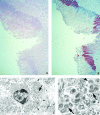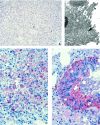Monkeypox transmission and pathogenesis in prairie dogs
- PMID: 15109408
- PMCID: PMC3322777
- DOI: 10.3201/eid1003.030878
Monkeypox transmission and pathogenesis in prairie dogs
Abstract
During May and June 2003, the first cluster of human monkeypox cases in the United States was reported. Most patients with this febrile vesicular rash illness presumably acquired the infection from prairie dogs. Monkeypox virus was demonstrated by using polymerase chain reaction in two prairie dogs in which pathologic studies showed necrotizing bronchopneumonia, conjunctivitis, and tongue ulceration. Immunohistochemical assays for orthopoxviruses demonstrated abundant viral antigens in surface epithelial cells of lesions in conjunctiva and tongue, with less amounts in adjacent macrophages, fibroblasts, and connective tissues. Viral antigens in the lung were abundant in bronchial epithelial cells, macrophages, and fibroblasts. Virus isolation and electron microscopy demonstrated active viral replication in lungs and tongue. These findings indicate that both respiratory and direct mucocutaneous exposures are potentially important routes of transmission of monkeypox virus between rodents and to humans. Prairie dogs offer insights into transmission, pathogenesis, and new vaccine and treatment trials because they are susceptible to severe monkeypox infection.
Figures



References
-
- Centers for Disease Control and Prevention. Multistate outbreak of monkeypox—Illinois, Indiana, and Wisconsin, 2003. MMWR Morb Mortal Wkly Rep. 2003;52:537–40. - PubMed
-
- Centers for Disease Control and Prevention. Update: multistate outbreak of monkeypox–Illinois, Indiana, Kansas, Missouri, Ohio, and Wisconsin, 2003. MMWR Morb Mortal Wkly Rep. 2003;52:561–4. - PubMed
-
- Centers for Disease Control and Prevention. Update: Multistate outbreak of monkeypox—Illinois, Indiana, Kansas, Missouri, Ohio, and Wisconsin, 2003. MMWR Morb Mortal Wkly Rep. 2003;52:642–6. - PubMed
-
- Reed KD, Melski JW, Graham MB, Regnery RL, Sotir MJ, Wegner MV, et al. The initial detection of human monkeypox in the western hemisphere: association with infected prairie dogs. N Engl J Med. In press. - PubMed
MeSH terms
LinkOut - more resources
Full Text Sources
Other Literature Sources
Medical
